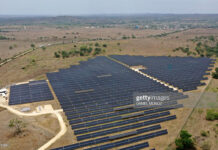By Dr. Lorraine Sobers
News Americas, PORT-OF-SPAIN, Trinidad, Fri. Jan. 21, 2022: Guyana is the steward of astounding natural resources ¾ luscious rainforest, gold, diamond, bauxite and hydrocarbon deposits. The industries built on these natural resources all have environmental and stewardship challenges.
The excitement of Guyana’s oil boom is somewhat tempered by environmental considerations and its international commitment to limit carbon emissions. From 2015 onwards, the world has been awestruck by the rapid discoveries of large hydrocarbon deposits found offshore Guyana. Oil production has joined the household of Guyanese extractive industries in spectacular fashion with over 20 economic discoveries in the Stabroek block, 10 billion barrels of oil equivalent in reserves and, production estimated to increase from 120,000 barrels of oil per day (bbl/d) in 2021 to 1,000,000 bbl/d by 2027—translating to tens of billions of US dollars in annual revenue for the government by the end of the decade. This column will look to Guyana’s older, more established extractive industries to quickly survey common supporting pillars of the burgeoning Guyanese oil sector and its natural resource sector.
Between the 1840s and 1910s, gold, bauxite and diamond mining became official operations in Guyana. In the decade after nationalization, Guyana’s bauxite production contributed to a significant portion, 13.9 percent, of the nation’s GDP and 43.4 percent of export earnings; gold production accounted for 42.8 percent of total exports by 2015 and diamond production has been on the upswing in recent years. But the revenue from oil production will dwarf all revenue of current mining operations combined. In just the first half of 2021, export earnings grew 63.6 percent, driven almost entirely by rising oil production.
The extractive industries are regulated by the Guyana Geology and Mines Commission (GGMC).They have developed codes and practices for mercury use, ground control (to prevent caving), mine effluents, cyanide use and other activities in keeping with the first pillar: safety and environmental protection. Multinational oil companies also know first-hand that smart regulations are key for responsible and sustainable operations. Nonetheless oil spill incidents can become indelible reminders of the risk of oil production. Pre-emptively, members of Guyana Defence Force Coast Guard have been trained to respond to any oil spill incidents in the territory. Guyana’s National Oil Spill Plan (NOSP) will have to keep up with increases in production and changes in activities as more wells come onstream. Increases in production and complexity of operations will also require a sophisticated, well-equipped, professional petroleum inspectorate to inspect rigs, vessels and monitor operations for regulatory and safety compliance.
The second pillar is the balance of commerce and conservation. Recently there has been a controversial call for the immediate ban of logging activities in Guyana. In response, the Guyana Forestry Commission (GFC) issued a statement which highlighted that Guyana’s forest stores 19.5 billon tons of carbon dioxide equivalents (tCO2e) and sequesters 154M tCO2e annually and, the logging production rate of 400,000 m3 is currently one-third of the maximum allowable for sustainable production. Inevitably, the balance struck by policy makers will be questioned, scrutinized and critiqued however, designated stewards, like the GFC, must be able to demonstrate that their policies and actions favour sustainability above pure commercial interest. Oil production in the 21st century, like forestry management, needs a delicate, data-based balance of commerce and conservation.
The third pillar, the value of data managed by Guyana’s national repository, should not be underestimated. In the mining sector fortunes are gained and lost on the quality, quantity and interpretation of data retrieved from the depths of the earth. Similarly, data collected from hydrocarbon exploration and production will provide revenue, not only in the production stage but also through future bid rounds whenever companies purchase data packages to prepare their bid to develop Guyana’s lucrative acreage.
Guyana can also create additional value in its acreage by retrieving data during exploration for oil to create a carbon storage atlas that identifies the size and location of potential geologic reservoirs for carbon dioxide (CO2). Carbon capture and storage (CCS) is tied to the first, second and third pillars. Guyana is a world leader in carbon storage through its forests. In the future, offsetting carbon emissions through geologic CO2 storage and sequestration can add to Guyana’s contribution to limiting CO2 emissions. Although in the short term there is no scope for CCS in ultra-deep acreage offshore Guyana, this technology deserves consideration simply because it is easier and much less costly to gather this information during the exploration and development phases than later on when production has been established. Application of CCS is more likely onshore or near shore prospect in the medium to long term. As industries are developed along the value chain, geologic CO2 storage sites can be allocated to each new industrial or petrochemical plant based on storage feasibility and capacity.
Carbon storage atlases have been created by several oil and gas producing countries and regions – South Africa, Western Europe and North America. There is much less activity in South America and the Caribbean but Guyana can become a gamechanger in this area.
Transparency is the fourth pillar. Before Guyana’s oil production began in December 2019, the country joined the Extractive Industries Transparency Initiative (EITI) reporting on their mining, fisheries and forestry activities. It is opportune that Guyana signed up for EITI reporting before its windfall oil production began to significantly impact government revenue and commercial activity. Guyana’s EITI consist of government, industry and civil society constituencies. The objective of the EITI is to implement “the global standard to promote the open and accountable management of oil, gas and mineral resources”. Guyana has committed to disclose information on its extractive industries for “greater transparency and accountability”. As such Guyanese can expect improved access to information through public disclosure of contracts, licences and permits related to all extractive industries including the oil and gas sector. Although it is a relatively recent initiative, this can put Guyana on better footing to create and maintain systems that ensure accountability and reduce opportunities for corruption during its rapid development and growth. Guyana has improved its ranking on Transparency International’s Corruption Perceptions Index by 13 points between 2012 and 2020 to 41/100 however, this score calls for continued improvement and sustained effort to increase transparency.
The arrival of oil and gas production brings opportunities for and threats to Guyana’s progress. Rapid growth in this sector may be bolstered by the pillars of Guyana’s established extractive industries or crumble under the weight of success, prosperity and responsibility. The future will demonstrate what Guyana deems to be a good balance between commerce and conservation; the importance of safety and environmental protection; the value placed on the national repository of natural resource data and, answer the big question – will corruption or transparency prevail.
EDITOR’S NOTE: Dr. Lorraine Sobers has 18 years’ experience in the energy sector. She is a Reservoir Engineer and lecturer at the University of the West Indies, St. Augustine. She is also the Project Coordinator for CO2 Emission Reduction Mobilisation Project and a Junior Fellow of the Caribbean Policy Consortium.









